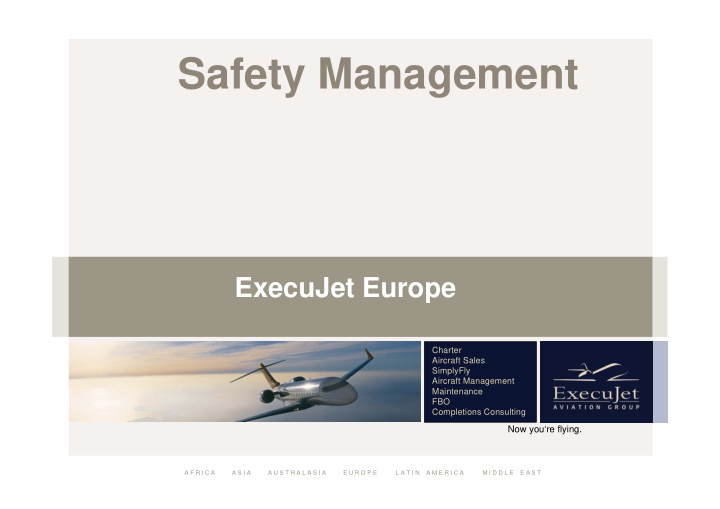



Safety Management ExecuJet Europe Charter Aircraft Sales SimplyFly Aircraft Management Maintenance FBO Completions Consulting Now you‘re flying. A F R I C A A S I A A U S T R A L A S I A E U R O P E L A T I N A M E R I C A M I D D L E E A S T
ExecuJet Europe Introduction • Part of the Lux Aviation Group • 8 AOC’s Within Europe • 150 Aircraft • 50/50 split between private and commercial operations • 13 Aircraft Registries • Centralized Services in Cambridge, UK
Safety Culture – Ideal Situation • Open reporting system • Regular internal and external audits • Regular feedback via Safety Action Group • Risk Assessment • Just Culture • Safety reports reviewed and responded to in good time • Mitigating actions put in place
Safety Culture – Difficulties • Cultural variations in attitude towards reporting • Fear of being blamed • Internal politics • Perceived damage to reputation Slow responses due to investigation especially if a 3 rd party is involved • • Implementing changes
SMS Framework Simplified Audit Review Aircraf t Incide How do we What do we nt check it not want to Identify worked? happen? possible causes Take How do we Appropriate prevent it Action happening? Live with it? Mitigate it? How bad & how often
Safety Factors - General • Operators/Owners failing to understand regulations or airworthiness requirements • Crew discussing maintenance issues directly with MRO without informing the CAMO • Aircraft flying without CAMO being given the CRS in advance • Aircraft flying without being released • CRS wording incorrect • Defects not recorded in technical log • Cabin log being used to defer airworthiness items such as seatbelts
Safety Factors – Owners/Operators Example • Owner wants to fly however during a back to birth records check an overdue life limited component is found to have expired several months earlier. • OEM contacted but unable to provide NTO. • MEL relief available to allow a flight to a maintenance base – gear down in this example. • Owner/Operator advised of the situation however they choose to fly the aircraft to fulfil the owners requirement. • Result. Aircraft Grounded for several days, MOR submitted to Registry who in turn demand full investigation which may result in the aircraft being removed from the register.
Safety Factors – Aircraft flying without CRS • Crew arrived at aircraft and could not find tech log onboard • Passengers arrived early for flight • Crew found tech log in the hangar where scheduled maintenance had been performed and took it away • Aircraft departed • Aircraft had not been released to service • Crew were not aware if maintenance had been completed • Investigation led to traffic light system being introduced into flight tracking software used by ExecuJet.
Safety Factors – Improvements • Traffic light system to show status of aircraft • Training to identify correct CRS wording • Crew trained to contact CAMO as first point of contact • Workpack flow checklists amended to prompt planning team to ensure items such as the tech log have been placed back on board. • Crew actively encouraged to report issues with both MRO and CAMO officially rather than informally • CAMO Staff encouraged to proactively report near misses • Regular cross-CAMO Safety Action Group meetings to discuss trending issues and work on positive solutions
Safety Factors – Conclusion • Communication – ensuring CAMO, Flight Crew and MRO know their responsibilities • Culture – ensuring that all staff understand the reasons why it is essential to report and that reporting is not a form of punishment but of improvement • Be proactive – Report near misses to avoid potentially catastrophic incidents Questions?
Recommend
More recommend